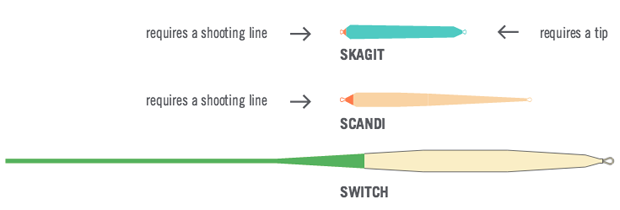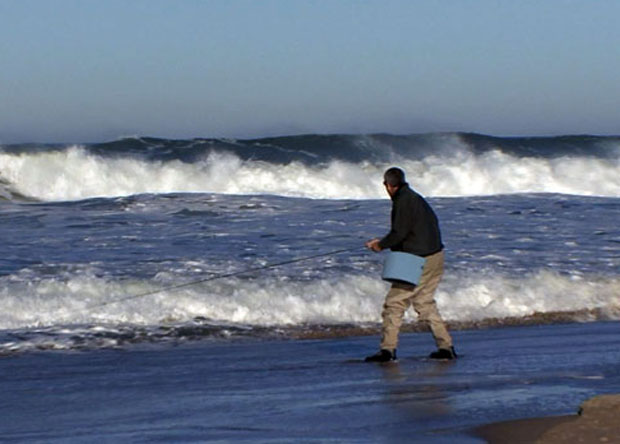Fishing on foot can be fantastic, but the deck is stacked against you compared to having a skiff or personal watercraft
[dropcap]F[/dropcap]ishing with conventional rods, 9-footers, in the surf is not only a workout, but the percentages of catching are against you. You just cannot get as far out as a surf-spinning outfit will get you. And there is the huge advantage of live or dead bait. Fly fishing can, however, be great when bait fish have been pushed shoreward by blues, snook, tarpon, crevalle, sharks, macks or other predatory animals. But search casting the surf can be frustrating.
To get some odds back on your side of the ledger consider a longer rod, a Switch rod to be exact
The advantage of a Switch rod is evident. One, its lever length will automatically increase, dramatically, your casting distance. Two, it will be physically easier on you body to two hand cast as opposed to one handed casting. However, that said, a one handed Switch rod cast is as easily doable as one handed overhand cast with a conventional 9-footer. And employing Joe Mahler‘s index finger on top of the handle further aids overhand casting in both distance and accuracy.
There is no negative for fishing a Switch rod from a skiff deck; none. A roll cast on a narrow Appalachian stream is as effective as using a beautiful 7-foot fiberglass 4-weight rod made by Dave Redington’s South Fork Rod Company.
Two handed negative speakers
The negatives of Switch rod need to be invented, and fly shops east of Cheyenne do a pretty good job at inventing. The exception to east of Cheyenne is any shop near the Great Lakes. The Great Lakes area shops are in all the way on Spey and Switch rods.
The one drawback to investing in a two handed rod is apparent. Choosing a fly line. What is Skagit, Scandi, length, grain weight and added tips? It tripped me up and in South Florida, at the time, no regional shop knew anything at all about Spey or Switch fly lines, with one exception, David Olson at the Fly Shop of Miami.
To get a true handle on two handed fly lines and added Skagit and Scandi tips, we went to RIO. They are way out front on a knowledge base regarding this fast growing segment of fly fishing.
How to select the right line for Switch rods in three easy steps by RIO Products:
1. Choose the line type:
There are three families of Spey lines for Switch rods: “Skagit,” “Scandinavian” and “Switch.”
Skagit: Shooting head – best for big flies and sinking tips – easy to cast. Skagit line is for anglers wanting to cast big flies and/or sink tips.
Scandinavian: Shooting head – ideal for smaller flies and better presentation – easy to cast. “Scandi” line for anglers who want to fish a floating line, or with smaller flies.
Switch: Integrated lines with attached running line. Switch line is used if you don’t want the hassle of connecting heads to shooting lines.
 2. Choose the right line weight:
2. Choose the right line weight:
“Spey” gets complicated because some lines are measured in “grains” not “line size.” Knowing the
grain range per line size helps you match a suitable grain weight line to a customer’s rod. Here’s a
grain weight to line size conversion guideline.
Novice casters should err towards the upper end of the grain range for Skagit heads and towards the lower end for Scandi heads.
Switch Lines have the same line designation as rods, so choose a #5 for a #5, a #7 for a #7 and so on.
One frequently missed conversion is that a rod requires less line weight to load it when overhead
casting, so if using a Switch rod for predominantly overhead casting, go with the lowest end of the .
above guideline
 3. Choose the right head length:
3. Choose the right head length:
“Switch” rods require a shorter head length to cast than regular two-handed “Spey” rods. RIO has
made it easy to choose the right line by using the word “Short” in the product name. Choose a Skagit Max Short for big flies or a Scandi Short VersiTip (depending on point 1 above) for example.
As far as the dedicated “Switch” lines go, the Switch line has a long head of around 55-feet, which is ideal for anglers that want the ability to mend at long range. Choose this if mending ability is one
of the primary considerations.
The Switch Chucker is short and very easy to cast. It is the best choice for anglers wanting an integrated line that will throw indicator rigs or sink tips, and a particularly excellent choice for novice Switch rod users.








